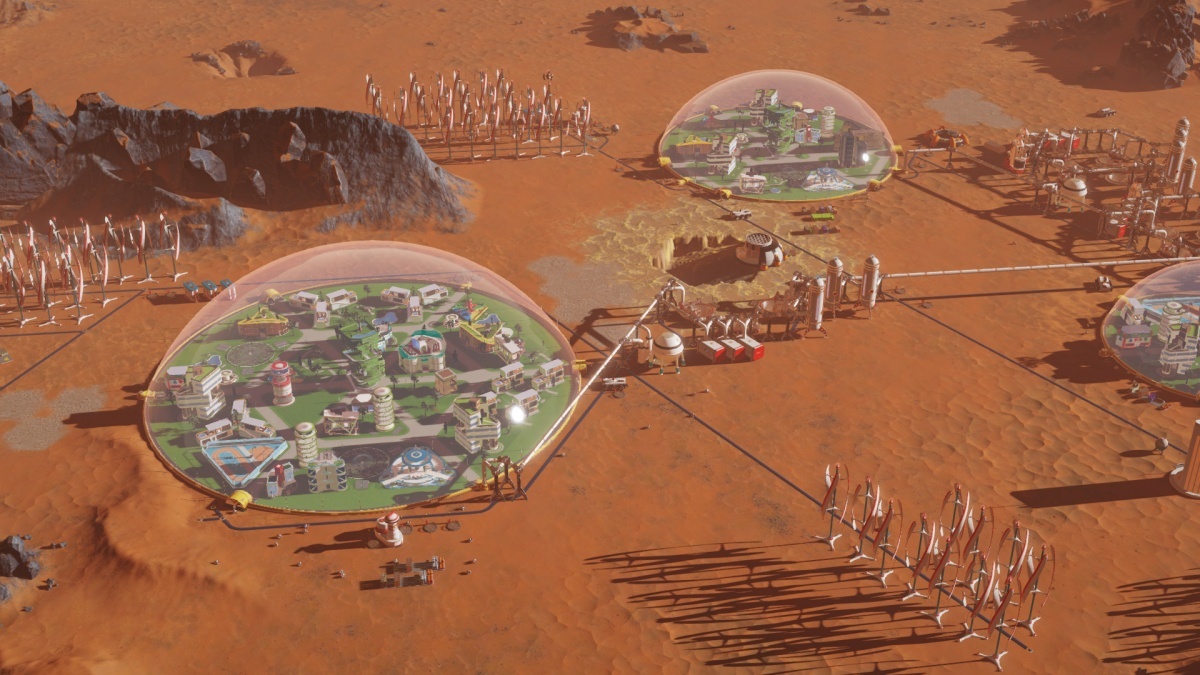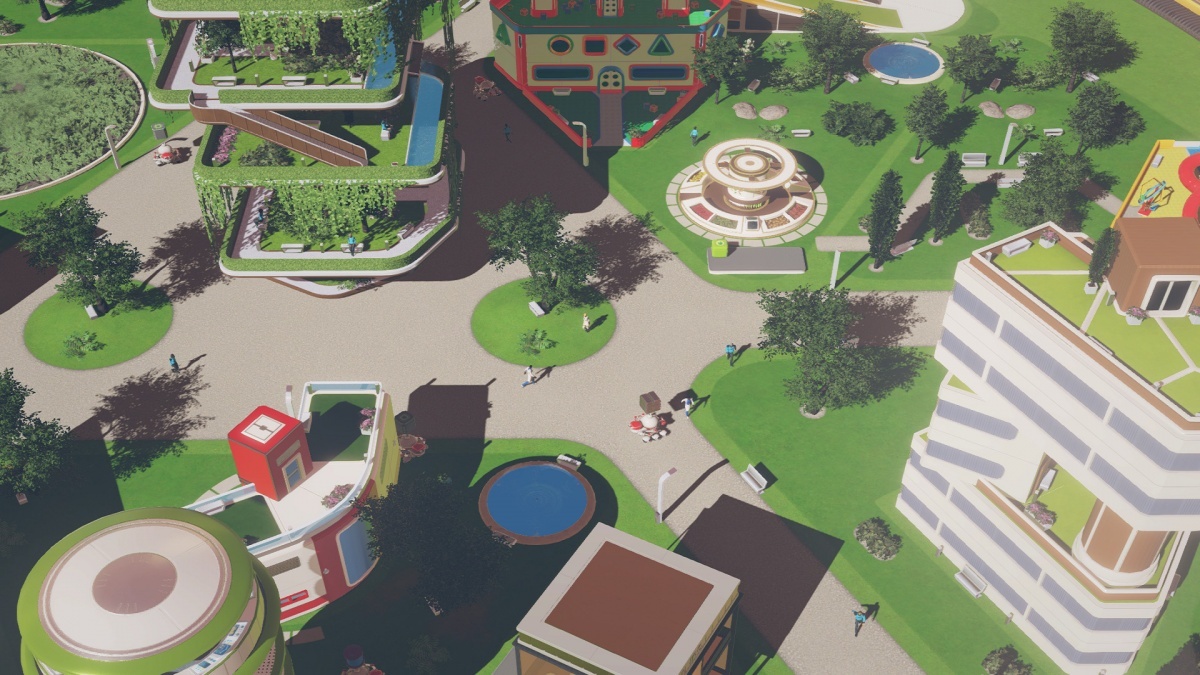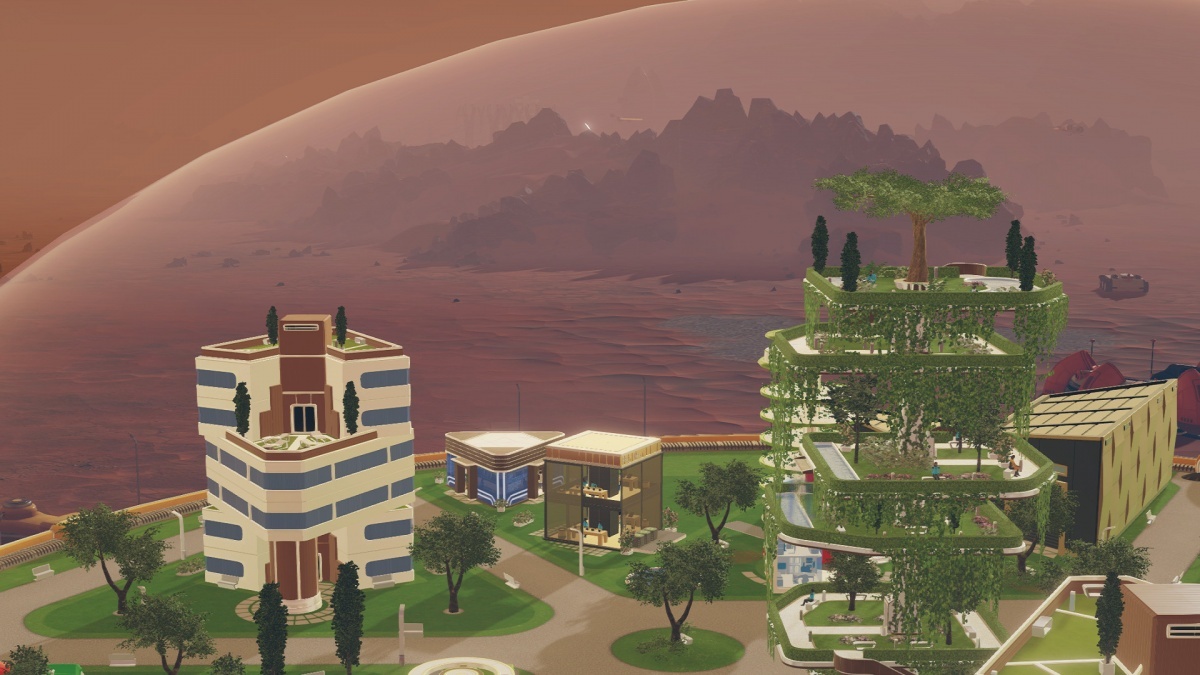Surviving Mars (Xbox One) Review
By Gabriel Jones  28.03.2018
28.03.2018

As his cargo shuttle touches down upon the planet's surface, Commander Stokes reviews his mission statement one last time. He has been chosen to lead the world's first colonisation effort on Mars. Thanks to a generous sponsorship by the United States, there aren't any immediate concerns about funding. The cargo ship has been stocked with all of the necessary building supplies, as well as an army of drones. Naturally, automatons are the best option for constructing the various facilities a colony requires. Expectations for the mission are quite high. The sponsors made a point of stating that Surviving Mars is not just some Cub Scout camping trip. Stokes must build a colony that's self-sustaining, a home to all walks of life. There will come a time when the planet Earth is nothing more than a distant memory. That same fate cannot befall mankind.
Once again, the future of humanity is hoisted upon the player's shoulders in Surviving Mars. Unlike other games that focus on defeating the alien menace, invaders from the underworld, or man's own hubris; the only tasks here are to build a thriving colony and ensure its stability in the face of any challenge. For some people, particularly those who don't play building-simulators, it can be a very tall order. The results of a decision are never immediately felt, so it is unlikely the full impact of mistakes will be understood until several hours have passed. To really appreciate what this title is going for, a serious time investment is necessary.
Generally, the path to a successful colony is achieving an equilibrium state. That means every resource is utilised to its fullest extent, nothing goes wasted, and facilities are never left without necessities, such as power or materials. The idea is to take a solid foundation and continue to build upon it, ensuring that no steps are skipped or rushed. Trying to move ahead too far in one direction will inevitably cause the entire colony to collapse. Again, the consequences are never immediate. If, for example, a dome loses power or runs out of food, the entirety of its inhabitants isn't going to immediately die. However, precious time and resources will be wasted trying to fix those problems; the colonisation effort is halted, and progress stops.

To better illustrate how damaging a faulty colony can be, consider "The Tale of Four Domes." This is a short guide on what not to do when colonising Mars. After completing the first dome and ensuring that it had the basic facilities such as housing and factories, Stokes called for the first settlers to arrive on Mars. However, when he sent in his request for volunteers, he didn't specify age, gender, and talents. Thus, when the passenger ship arrived, the commander was greeted by twelve senior citizens. They were far too old to do any work, so the factories remained abandoned. Before long, the solar panels and turbines fell into disrepair, and the entire colony suffered a blackout. Stokes was forced to spend billions to request another cargo ship, because his factories weren't churning out the electronic and machine parts that were needed to keep the colony running.
Realising the costly mistakes he had made, Stokes had his drones build a new dome, one that contained research labs, clinics, diners, and farms. This time, he also demanded that the arriving colonists were actually capable of working. Unfortunately, the fatal flaw in this dome was that there wasn't any housing. Rather than remain homeless, everyone chartered ships to dome #1, aka "The Retirement Dome." All of those labs and food production facilities were left to decay. Without any food, everyone began to starve. In most cases, drones would be perfectly adept at schlepping necessities between domes, but nothing was being produced. Once again, the commander was forced to make a very expensive and time-consuming request for supplies.
More efficient housing, plenty of factories and mines to work in - the third dome had it all. Once Stokes got everything up and running, this dome was churning out essential resources at a ridiculous pace. Furthermore, the rare metals were being sent back to Earth, earning more money in case further emergencies occurred. Once again, however, this dome had a major problem. While overseeing the colony, the commander received a message: one of the colonists had died, and it wasn't from old age. The stress of constant work and living in a sardine can of an apartment finally caught up to him. Before long, other colonists started passing away. The remaining survivors chartered the next passenger ship off of Mars. In just a short time, there wasn't anyone working in dome #3, and the entire colony collapsed…again.

Ensuring the health and happiness of the colonists is one of the more important aspects of Surviving Mars. If all they have to look forward to in life is working in the mines, they will lose interest in everything else life has to offer, including sex. While it is a little mind-numbing to account for every individual's traits, some effort should be made to care for their wellbeing. They are not just another resource that does the jobs drones can't. In time, they will meet other people, and start making some babies. Provided those kids get the training they need, they will be more skilled when they enter adulthood, and thus become more efficient workers. Plus they are less likely to succumb to the stress of living on such an inhospitable environment.
Anyway, time to continue on by discussing the fourth dome. Oh wait, that dome was never actually built. Talk about a twist ending! Originally, it was planned to be quite magnificent. It would have spacious housing, plenty of amenities, and a network of tunnels that would connect and provide for all of the other domes. It was the colony's most ambitious project to date, but it never got off the ground. Its construction was continually delayed by the other three domes and their constant issues. It would take many sols and trillions of dollars before the colony achieved some level of self-sufficiency. On the bright side, this failure turned out to be quite a learning experience for Commander Stokes. The next colony he oversees is certain to turn out much better.
What makes this game so compelling is that it rewards both persistence and efficiency. It's normal for players to spend fifteen or so hours on their first colony, only to be displeased with the final results. In time, they learn the intricacies of building and arranging every facility, so that drones can quickly attend to repairs. Resources are carefully managed and time isn't wasted. Planning ahead will make it easier to deal with any and all calamities that are bound to occur, such as the destruction of Earth and its potential impact on Mars. Many of the achievements are also tied to specific challenges, which require colonies to be built in a particular manner, before 100 sols pass. It's a good idea to keep that first colony around to experiment with, before attempting a challenge run.

Building simulators are not exactly a common genre on consoles, but the developer did a decent job accounting for the limitations of a control pad. Granted, it will probably take quite a while for players to grasp the full extent of the controls, but that's mainly because commands are mapped to every button. Eventually they will adjust. One nuisance is that domes, vehicles, and other major facilities have their own slots on the bottom of the screen. If wanting to check on their status, there is a need to repeatedly press the RB and LB buttons to switch between them. The UI in general can also cause eyestrain. Even on a 50" TV screen, viewers will have to sit awfully close in order to make out the small text and tiny map details. At least the in-game timer can be paused, allowing all of the time needed to check on the colony's every facet and make decisions.
There are also a couple of other aspects that feel a little undercooked. Remote-controlled transports can move resources or gather minerals scattered throughout Mars. However, players are often forced to spend an inordinate amount of time babysitting them. The rover has some basic routing functionality, but it can't be automated to scout for veins, mine them, and then return to the domes. As the colony expands, less attention will likely be paid to the vehicle, especially when small shuttles tend to be faster and more efficient. Storage landings, which are free to build, make perfect locations for the flying ships to drop off supplies. Also, not many people are going to bother with learning too much about the colonists. Some are specialised in different fields, or have negative traits that can affect performance. In most cases, however, they are just a body that takes up a slot in a factory or a lab. Attempting to account for the particulars is a waste of time, especially in the early stages of the colony.
As a reminder, there's no such thing as a "quick game." While there is an option that quickly generates a map, as well as the commander's sponsors and perks, the average game is still liable to take over ten hours. This is generally how long it takes for the 100 sol deadline to occur. Mysteries, which can be chosen at the beginning of a play-through, or set to appear at random, will also take a very long time to play out. This title is a massive time sink, which is exactly what is expected of the genre. Thankfully, the mundanity is kept at bay due to a fast-forward option. Just be sure to check the time whenever the game is saving, because real-life hours will pass by very quickly.

Cubed3 Rating
Great - Silver Award

Ideally, players should try to experience Surviving Mars on the PC, but the Xbox One version is a fine substitute. In any case, they are treated to a very impressive simulator that rewards expert resource-management. The emphasis on automated drones helps to streamline all of the menial tasks, leaving players plenty of time to focus on constructing the perfect colony. Of course, the game features a steep learning curve, but there's always something new to learn. A few features, such as the individual characteristics of every colonist, are a bit convoluted and unnecessary. Still, maybe there is somebody out there that appreciates the extremely fine details. All in all, there's little stopping everyone from spending many sleepless nights attempting to conquer the planet.

![]() 8/10
8/10
![]() 0
(0 Votes)
0
(0 Votes)
 Out now
Out now  Out now
Out now  Out now
Out now  Out now
Out now Comments
Comments are currently disabled

 Sign In
Sign In Game Details
Game Details Subscribe to this topic
Subscribe to this topic Features
Features





 Top
Top

